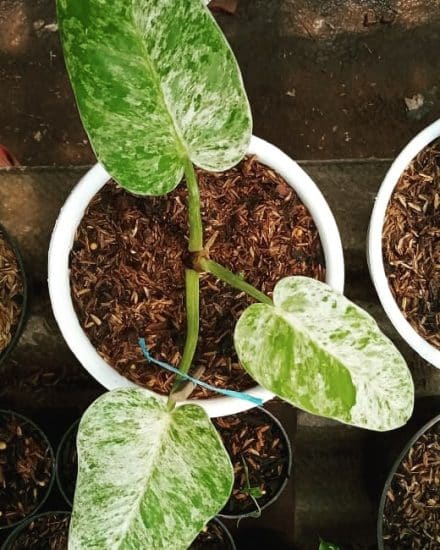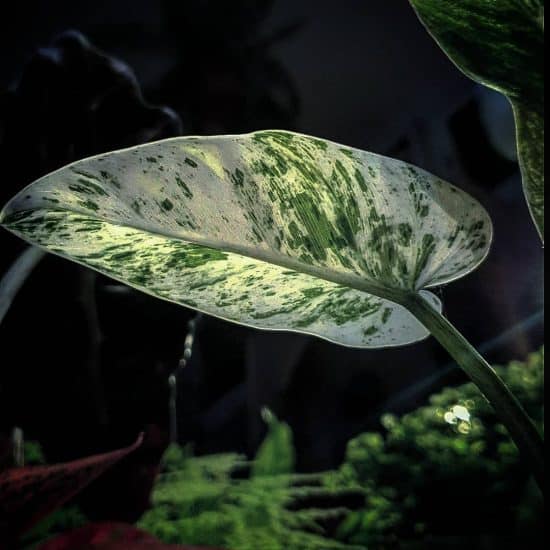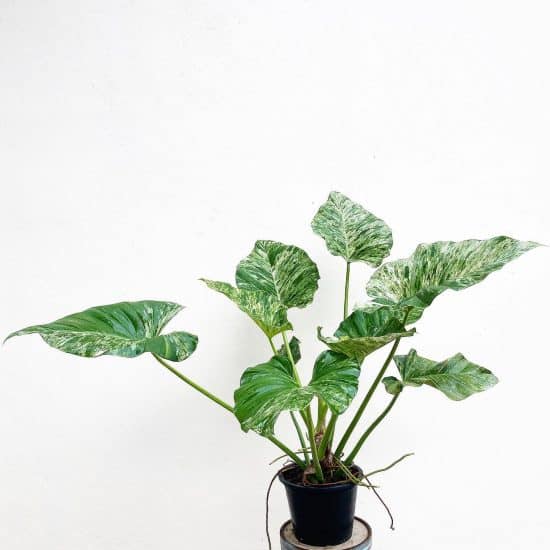Philodendron Giganteum is a dramatic giant lurking in the world of houseplants.
Now, you might be thinking, “A gigantic plant? Will it even fit in my home?” Well, fear not! While the Giganteum is a tropical plant that grow pretty large, it’s also easily tamed with proper care and attention. You should be able to get it through the door.
To help you care for your gentle giant, we’ll introduce you to the basics of Philodendron Giganteum care and maintenance, from watering to propagating and everything in between.
Table of Contents
Philodendron Giganteum Plant Care Guide
History, Habitat, and Characteristics

Philodendron Giganteum (Philodendron giganteum) belongs to the Araceae family. It’s a tropical plant native to the Caribbean islands and south into Venezuela and Brazil.
This climbing aroid is right at home in its native environment, wrapping itself around trees as it emulates their upward journey. With over 3,000 species in the Araceae family, we have to say, Philodendron Giganteum really stands out with its larger-than-life character!
The most remarkable feature of Philodendron Giganteum is, you guessed it, its size! This green giant doesn’t hold back as it stretches its dark-green leaves up to a jaw-dropping 5 feet in length. The plant also develops sturdy, elongated petioles to support its heavy foliage as it matures. It grows up to 4 feet tall indoors and 15 feet tall outside.
At first glance, you might think you’re seeing an alocasia plant, thanks to its bushy growth pattern, but those climbing stems will soon emerge as the plant reaches for the skies. Like other healthy plants in the aroid family, Philodendron Giganteum forms aerial roots that the plant uses in its natural habitat to climb trees.
Although Philodendron Giganteum has a lot in common with its philodendron cousins in terms of care, its impressive stature adds a touch more complexity. Giving this plant a sturdy pole to climb up is crucial for healthy and happy growth.
Although Philodendron Giganteum, also referred to as the “giant philodendron,” can reach an astounding 5 feet in leaf length, its size ultimately depends on the care it gets from its human companion. Pruning it back in the spring will help control its size.
If you’re feeling particularly indulgent, look for the variegated version of Philodendron Giganteum (Philodendron giganteum ‘Variegata’). With a mesmerizing blend of green, cream, and occasional pink hues, it almost looks like camouflage.
Fun fact: Philodendron Giganteum is a thermogenic plant, meaning it’s capable of raising its own temperature, and it’s also known to emit a sweet scent.
Light

Philodendron Giganteum grows best in filtered morning light, and placing it near a window with a tree outside works wonders. The sun’s bright light peeking through the tree’s branches and leaves will provide your plant with the perfect balance of brightness and indirect exposure.
If you’re short on strategically placed trees, an east- or west-facing window should do fine. Just be sure to keep it out of too much direct sunlight, especially during the hottest part of the day.
If you’ve got only low-light conditions, or for those inevitable gloomy days, use a grow light or fluorescent light to replicate the ideal habitat. And if all you have is a too-bright south-facing window, use a sheer curtain to create the perfect bright, indirect light for your Philodendron Giganteum.
If you’re not getting the lighting right, your plant will show signs. Keep an eye on your Philodendron Giganteum and watch for slow growth and drooping leaves. These signs indicate it’s not getting enough light. Too much light, on the other hand, will cause scorched leaves or unsightly brown spots.
Our lighting tips:
- Give Philodendron Giganteum bright, indirect light.
- Place your plant where it’ll receive filtered morning light or dappled sunlight.
- Don’t hesitate to use a grow light when dealing with darker days or shaded windows.
- Avoid overexposure to harsh direct light.
Water

Philodendron Giganteum likes a consistently moist soil, but will react poorly to soil that stays wet. To achieve ideal soil moisture for Philodendron Giganteum, touch the soil with your fingers, and when the top inch or two is dry, go ahead and water.
Make sure you water thoroughly, allowing the water to drain through the bottom of the pot. This way you know your Philodendron Giganteum has taken in all the water it needs and let the rest go. Use a drip tray that has depressions or pebbles in it so the roots of your giant philodendron aren’t sitting in a puddle.
Philodendron plants need less water in winter than they do during the growing season of spring and summer. Reduce your watering considerably during the winter, and keep an eye out for signs you’re not striking the right balance.
Signs your Philodendron Giganteum isn’t getting enough water:
- Slow growth
- Drooping or wilting leaves
- Brown or crispy leaves
- Hard soil beginning to separate from the side of the pot
Signs your Philodendron Giganteum is getting too much water:
- Yellow or pale leaves
- Wilted leaves combined with wet soil mix
- Mushy, drooping stems
- Fungus gnats
- A foul odor coming from the soil
Temperature and Humidity

Since Philodendron Giganteum is a tropical plant that comes from a warm climate, it thrives between 50-85°F. Be cautious of sudden temperature drops lower than 55°F, which can stress your plant. If your giant philo spends time outdoors, bring it back inside if temperatures go below 50°F.
When it comes to moisture, aim for a moderate humidity range of 40%-60%. Your Philodendron Giganteum will appreciate regular misting and leaf cleaning to maintain proper humidity levels. It’s also a good idea to use a humidifier, especially during dry winter months.
Keep an eye out for signs of too much or too little humidity. Drooping leaves or brown tips may indicate low humidity, while yellowing leaves or mold growth could be a sign of excess humidity.
Spot temperature stress by looking for wilting or drooping leaves (indicating high temperatures) or curling and darkening leaves (suggesting exposure to cold drafts or low temperatures).
To raise humidity:
- Use a humidifier near your plant, especially in winter when indoor humidity tends to be lower.
- Regularly but lightly mist your Philodendron Giganteum to support optimal humidity levels. This has the added benefit of cleaning the giant leaves, which will easily collect dust.
- Place your giant philodendron on a tray filled with pebbles and water to boost local humidity.
- Group your Philodendron Giganteum with other plants in your houseplant collection to create a humid microclimate through transpiration.
Soil and Planting

Philodendron Giganteum needs good drainage, aeration, and moisture retention. Let’s explore the ingredients for the best soil composition for this giant plant.
Our recommended soil mix:
- Organic material: Orchid bark and coconut husk, or coir, increase aeration, providing essential oxygen to the roots and improving overall soil structure. These materials help the soil retain moisture and are more eco-friendly than traditional sphagnum peat moss.
- Perlite: This volcanic material ensures drainage and prevents roots from sitting in overly moist soil, avoiding root rot caused by poor drainage.
- Coconut chips. Slightly coarser than coco coir, coconut chips offer extra aeration and drainage.
For added nutrients, incorporate earthworm castings, occasional sterile compost, and leaf mulch. Remember, soil density may compact over time, so you can add additional ingredients to increase the airiness of the mix when you repot.
This fast-growing plant likes to be a bit rootbound, so you won’t have to repot as often as you might think. When roots start emerging from the bottom of the pot’s drainage holes, it’s probably time. Pick a container only an inch or two bigger than the current one and pop in some fresh soil mix. For best results, do this in spring or early summer.
Fertilizing
Since Philodendron Giganteum grows quickly, you’ll want to fertilize your plant regularly during the growing season. Do this every time you water, and use a quarter-strength, balanced organic fertilizer.
Watch for signs of excessive fertilization, like yellowing leaves or burnt tips, and adjust the fertilization frequency or concentration accordingly. Avoid using chemical fertilizers that may harm your Philodendron Giganteum.
Tropical plants go slightly dormant during the winter, so stop fertilizing in early fall to give your plant a break. Take up the cause again in early spring.
Propagation

Propagating your Philodendron Giganteum is an easy and fun way to create new plants, expand your collection, or share with friends. With this simple stem-cutting method, you’ll be on your way to growing a new giant philodendron in no time!
Propagating Philodendron Giganteum by stem cuttings:
- Find a mature plant with a visible aerial root or two and vibrant heart-shaped green leaves. It’s essential to pick a strong, healthy mother plant to ensure your Philodendron Giganteum propagation project is a success.
- Snip the top part of the plant with a clean pair of gardening shears and carefully take a stem cutting. This cutting will be the start of your new Philodendron Giganteum plant.
- Optional: Seal the cut area on the parent plant with a bit of candle wax. This helps protect the remaining plant from any harmful germs and keeps it healthy. You can also dip your cutting in rooting hormone to encourage root growth.
- Fill a new pot with a well-draining soil mix containing added perlite and succulent mix. This which will improve aeration and prevent rot. Gently plant the cutting, ensuring the roots have enough space to grow and spread out, but not so much extra room that it’ll be overwatered.
- Give the cutting a nice drink of water and make sure its roots are well-planted in the soil. After repotting, water your new Philodendron Giganteum cutting to help it settle into its new home. Remember to keep the soil moist but not wet, and give it plenty of indirect sunlight as it grows.
Our propagation tips:
- Always choose healthy plants and stems for propagation.
- Keep your newly propagated giant philo cutting moist (but not sopping) and plant in bright, indirect light.
- For the best chance at success, plan your propagation for the growing season — spring or early summer is perfect!
- Use rooting hormone on the end of your giant philo cutting to encourage root growth.
Common Issues

Caring for a giant philo can be a truly rewarding experience, but as with all rare plants, being aware of common pests and potential diseases is crucial.
Yellow Leaves
Yellow leaves on your philodendron plant could indicate several issues, such as overwatering, sudden temperature changes, or exposure to drafts. To address this problem, first check the soil’s moisture level. Overwatering can lead to issues, so allow the top of the soil to dry out a bit between waterings, and make sure your pot has proper drainage.
To prevent temperature stress, keep your tropical plant away from drafty windows or vents, and maintain a consistent room temperature. This is particularly important if you’ve recently moved your giant philo plant outdoors during cooler spring days — sudden changes can shock the plant.
Leggy Growth
Leggy growth with a Philodendron Giganteum is often due to low light or insufficient support for its natural climbing habit. Both can lead to long, thin leaf stalks and sparse foliage distribution.
To help your climbing plant regain its natural growth pattern, provide a suitable support structure, such as a moss pole or trellis (or even train your giant philo plant to climb a nearby piece of furniture). Introducing support encourages the plant to produce aerial roots, which are a natural part of its climbing behavior.
Also, ensure your plant is getting the right amount of light to encourage healthy growth. Bright, indirect sunlight is ideal for a thriving Philodendron Giganteum.
Pests and Diseases

Care for Philodendron Giganteum is usually no fuss, but occasionally, this tropical plant might face some common issues. We’ll help you identify and treat typical Philodendron Giganteum diseases like root rot and fungus.
Root Rot
This issue pops up when we accidentally overwater our plants, or when the pot doesn’t have proper drainage holes. Signs that your plant might be struggling with rotting roots include yellowing leaves, wilting, dark, mushy roots, and a gross smell.
To fix rot:
- Gently remove the plant from its pot and use sterile scissors to trim any affected roots.
- Allow the roots to dry out a bit before replanting them in fresh, well-draining soil (adding perlite or pumice could help with aeration and drainage) in a pot with drainage holes.
- Keep an eye on your watering routine. Only water your plant when the top 2 inches of soil feel dry.
Fungal Infection
Fungus can be a sneaky issue for your Philodendron Giganteum. You might notice white, powdery patches on the leaves or stems, giveaway signs of a fungal problem.
Here’s how to tackle fungus:
- Isolate the affected plant from its neighbors so the fungus doesn’t spread.
- Use sterile scissors to carefully snip off any affected leaves and stems.
- Apply a fungicide according to the instructions on the label.
- Make a habit of wiping the leaves with a damp cloth to keep the fungus from making a comeback.
Pests
Even though your Philodendron Giganteum isn’t a pest magnet, sometimes common pests, such as mealybugs, spider mites, and aphids can cause problems. Be on the lookout for tiny bugs on leaves, webbing, or damaged foliage — these could be signs of a pest invasion.
If your plant becomes a hang-out spot for pests, follow these steps:
- Separate your infested green buddy from your other plants.
- Use a damp cloth or water spray to gently remove any visible pests from leaves and stems.
- Treat your plant with neem oil or an insecticidal soap according to the product’s instructions.
- Regularly inspect your plant and give its leaves a good wipe — this way, you can catch any new infestations early on.
Pseudomonas Leaf Spot
Pseudomonas leaf spot is a rare bacterial disease caused by too much humidity. It causes unattractive, moist lesions on your plant’s leaves, but is frequently confused with other, less serious problems. These lesions, which can appear in a variety of colors, will quickly grow and spread, so you must act quickly.
Unfortunately, the best way to prevent it from spreading is to destroy the plant. There is no cure for bacterial leaf spot and it will spread to your other houseplants if you attempt it. The best way to prevent it is to avoid wetting the leaves of your plants.
Conclusion

That’s a wrap on our Philodendron Giganteum care guide! Armed with this knowledge, you’ll be able to confidently care for and maintain your very own tropical giant.
Philodendron Giganteum care summary:
- Find the right balance of bright, indirect light to promote growth and overall health.
- Water when the top 1 or 2 inches of soil are dry, and watch out for signs of overwatering.
- Maintain consistently warm temperatures and moderate humidity levels to keep your plant comfortable and happy.
- Propagate in spring or early summer using stem cuttings.
- Troubleshoot any issues like pests, root rot, or infection with timely intervention and proper care techniques, like neem oil.
If you found this guide helpful, feel free to share it with others who might benefit! And as always, if you have any questions or concerns, don’t hesitate to reach out to us.
Take care, and happy planting!
FAQ
Is Philodendron Giganteum a climber?
Philodendron Giganteum is a climber with large, upright plant stems and massive leaves, though it doesn’t climb as easily as smaller species. This is because it has to grow quite large before it begins to climb, and it’s usually kept pruned indoors.
However, if you have the space and you provide it with appropriate support, like a sturdy moss pole or telephone pole (just kidding — or am I?), it may climb as it grows.
Is Philodendron Giganteum rare?
While Philodendron Giganteum isn’t the most common houseplant, it isn’t extremely rare either. With its massive, beautiful leaves, it’s become increasingly popular recent years.
That being said, you might not find it at your local garden center as readily as other philodendron varieties. To purchase one, try specialty plant shops or reputable online retailers that carry a wide selection of houseplants.
Is Philodendron Giganteum toxic?
Yes, Philodendron Giganteum is considered toxic to pets and humans. Like other philodendron species, it contains calcium oxalate crystals.
If you suspect your pet has chewed on or ingested part of the plant, consult your veterinarian immediately. As a precaution, keep your Philodendron Giganteum plant out of reach of pets and young children. If you’re concerned about toxicity, consider opting for nontoxic houseplants instead.
What are the differences between Philodendron maximum vs Philodendron giganteum?
Philodendron maximum and Philodendron giganteum are similar in appearance but have some differences in terms of size and growth habits. Philodendron maximum is slightly smaller than Philodendron giganteum, with leaves reaching up to 3 feet in length as opposed to the giganteum’s leaves, which can grow up to 4 feet or more.
Additionally, Philodendron maximum will easily and readily climb structures, such as trees or moss poles, while Philodendron giganteum needs more coaxing to exhibit its climbing nature, and will happily grow without support.
Both plants are native to Central and South America, and they share similar care requirements, such as temperature, humidity, and light preferences. When choosing between the two, consider your space requirements and preferred growth habits to ensure the best fit for your home.


